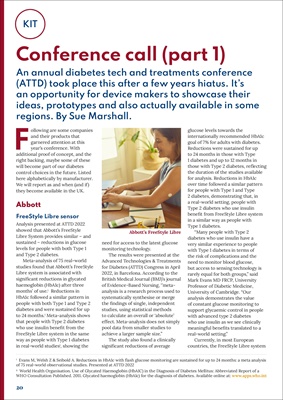
20
KIT
Conference call (part 1)
An annual diabetes tech and treatments conference
(ATTD) took place this after a few years hiatus. It's
an opportunity for device makers to showcase their
ideas, prototypes and also actually available in some
regions. By Sue Marshall.
Following are some companies
and their products that
garnered attention at this
year's conference. With
additional proof of concept, and the
right backing, maybe some of these
will become part of our diabetes
control choices in the future. Listed
here alphabetically by manufacturer.
We will report as and when (and if)
they become available in the UK.
Abbott
FreeStyle Libre sensor
Analysis presented at ATTD 2022
showed that Abbott's FreeStyle
Libre System provides similar - and
sustained - reductions in glucose
levels for people with both Type 1
and Type 2 diabetes.
Meta-analysis of 75 real-world
studies found that Abbott's FreeStyle
Libre system is associated with
significant reductions in glycated
haemoglobin (HbA1c) after three
months' of use.i Reductions in
HbA1c followed a similar pattern in
people with both Type 1 and Type 2
diabetes and were sustained for up
to 24 months.i Meta-analysis shows
that people with Type 2 diabetes
who use insulin benefit from the
FreeStyle Libre system in the same
way as people with Type 1 diabetes
in real-world studiesi, showing the
need for access to the latest glucose
monitoring technology.
The results were presented at the
Advanced Technologies & Treatments
for Diabetes (ATTD) Congress in April
2022, in Barcelona. According to the
British Medical Journal (BMJ)'s journal
of Evidence-Based Nursing, ''metaanalysis
is a research process used to
systematically synthesise or merge
the findings of single, independent
studies, using statistical methods
to calculate an overall or 'absolute'
effect. Meta-analysis does not simply
pool data from smaller studies to
achieve a larger sample size."
The study also found a clinically
significant reductions of average
glucose levels towards the
internationally recommended HbA1c
goal of 7% for adults with diabetes.
Reductions were sustained for up
to 24 months in those with Type
1 diabetes and up to 12 months in
those with Type 2 diabetes, reflecting
the duration of the studies available
for analysis. Reductions in HbA1c
over time followed a similar pattern
for people with Type 1 and Type
2 diabetes, demonstrating that, in
a real-world setting, people with
Type 2 diabetes who use insulin
benefit from FreeStyle Libre system
in a similar way as people with
Type 1 diabetes.
"Many people with Type 2
diabetes who use insulin have a
very similar experience to people
with Type 1 diabetes in terms of
the risk of complications and the
need to monitor blood glucose,
but access to sensing technology is
rarely equal for both groups," said
Mark Evans MD FRCP, University
Professor of Diabetic Medicine,
University of Cambridge. "Our
analysis demonstrates the value
of constant glucose monitoring to
support glycaemic control in people
with advanced type 2 diabetes
who use insulin as we see clinically
meaningful benefits translated to a
real-world setting."
Currently, in most European
countries, the FreeStyle Libre system
i Evans M, Welsh Z & Seibold A. Reductions in HbA1c with flash glucose monitoring are sustained for up to 24 months: a meta analysis
of 75 real-world observational studies. Presented at ATTD 2022
ii World Health Organisation. Use of Glycated Haemoglobin (HbA1C) in the Diagnosis of Diabetes Mellitus: Abbreviated Report of a
WHO Consultation Published. 2011. Glycated haemoglobin (HbA1c) for the diagnosis of diabetes. Available online at: www.apps.who.int